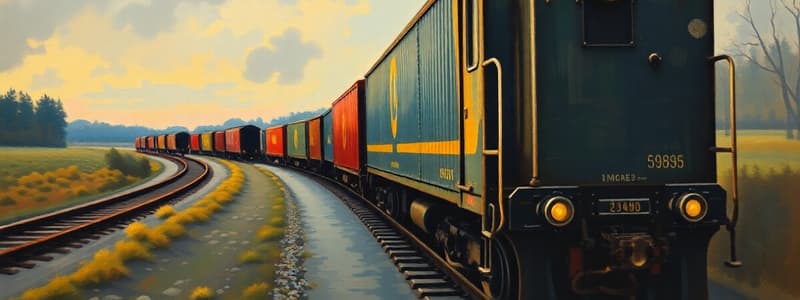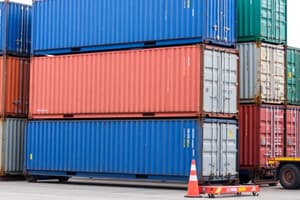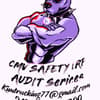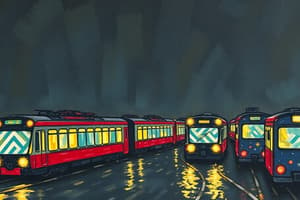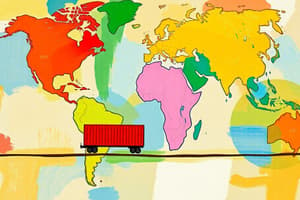Podcast
Questions and Answers
What is the primary focus of Tactical Transportation Management?
What is the primary focus of Tactical Transportation Management?
- Carrier sourcing and contracting
- Shipment monitoring and issue resolution (correct)
- Overall logistics cost reduction
- Performance analytics for carriers
Which of the following is NOT a key to successful transportation management?
Which of the following is NOT a key to successful transportation management?
- Increase freight costs intentionally (correct)
- Fully leverage a TMS
- Create global ownership
- Hold carriers accountable
Which key performance indicator is most relevant for analyzing carrier performance?
Which key performance indicator is most relevant for analyzing carrier performance?
- Internal allocation of freight costs
- TMS rate load maintenance
- Carrier scorecards (correct)
- Freight claims processing time
What is one significant challenge in the air cargo industry?
What is one significant challenge in the air cargo industry?
What percentage of US business logistics costs is spent on transportation?
What percentage of US business logistics costs is spent on transportation?
What is a primary advantage of asset-based 3PLs?
What is a primary advantage of asset-based 3PLs?
What is a concern associated with non-asset-based 3PLs?
What is a concern associated with non-asset-based 3PLs?
Which of the following services is primarily offered by freight management?
Which of the following services is primarily offered by freight management?
What is one of the top strategic needs for 3PL shippers?
What is one of the top strategic needs for 3PL shippers?
What does a dedicated fleet in a 3PL context primarily provide?
What does a dedicated fleet in a 3PL context primarily provide?
Which of the following is projected to increase in freight activity by 2050?
Which of the following is projected to increase in freight activity by 2050?
What does the freight forwarding service primarily focus on?
What does the freight forwarding service primarily focus on?
Which factor increased congestion costs in logistics from 2016 to 2021?
Which factor increased congestion costs in logistics from 2016 to 2021?
What is a primary purpose of a Transportation Management System (TMS)?
What is a primary purpose of a Transportation Management System (TMS)?
Which of the following is a tactical functionality of a TMS under the 'Execute' category?
Which of the following is a tactical functionality of a TMS under the 'Execute' category?
What is one of the key challenges faced by shippers today?
What is one of the key challenges faced by shippers today?
Which of the following functionalities is included in the strategic category of a TMS?
Which of the following functionalities is included in the strategic category of a TMS?
What factor strongly motivates organizations to invest in a TMS?
What factor strongly motivates organizations to invest in a TMS?
Which of the following best describes 'collaboration with carriers'?
Which of the following best describes 'collaboration with carriers'?
What is a benefit of having better analytics in transportation?
What is a benefit of having better analytics in transportation?
Which of the following is NOT a current challenge for shippers?
Which of the following is NOT a current challenge for shippers?
Flashcards
Asset-Based 3PL
Asset-Based 3PL
A third-party logistics provider that owns the assets and workforce needed for transport and logistics.
Non-Asset Based 3PL
Non-Asset Based 3PL
A third-party logistics provider that contracts with other companies to run transport and logistics
3PL Transport Services
3PL Transport Services
Third-party logistics services that focus on moving freight, managing transportation, and operating fulfillment centers
3PL Distribution Services
3PL Distribution Services
Signup and view all the flashcards
Freight Management (3PL)
Freight Management (3PL)
Signup and view all the flashcards
3PL Dedicated Fleet
3PL Dedicated Fleet
Signup and view all the flashcards
Top outsourced activities (3PL)
Top outsourced activities (3PL)
Signup and view all the flashcards
3PL Shipper Needs
3PL Shipper Needs
Signup and view all the flashcards
DSV Top Cargo Airports
DSV Top Cargo Airports
Signup and view all the flashcards
Unit Load Devices (ULDs)
Unit Load Devices (ULDs)
Signup and view all the flashcards
US Business Logistics Costs (USBLC) Spend on Transportation
US Business Logistics Costs (USBLC) Spend on Transportation
Signup and view all the flashcards
Transportation Management (Tactical)
Transportation Management (Tactical)
Signup and view all the flashcards
Strategic Transportation Management
Strategic Transportation Management
Signup and view all the flashcards
TMS
TMS
Signup and view all the flashcards
TMS Key Functionalities
TMS Key Functionalities
Signup and view all the flashcards
Tactical TMS Planning
Tactical TMS Planning
Signup and view all the flashcards
Tactical TMS Execution
Tactical TMS Execution
Signup and view all the flashcards
Tactical TMS Settlement
Tactical TMS Settlement
Signup and view all the flashcards
Strategic TMS Carrier Sourcing
Strategic TMS Carrier Sourcing
Signup and view all the flashcards
Strategic TMS Carrier Management
Strategic TMS Carrier Management
Signup and view all the flashcards
TMS Investment Motivations
TMS Investment Motivations
Signup and view all the flashcards
Study Notes
Railroads & Intermodal
- Train accidents have decreased since 2000, with fatalities and injuries down by 44%.
- Boxcars are standardized freight cars used for general commodities, adaptable for specialized goods.
- Hopper cars are used for bulk materials, with covered hoppers protecting goods from the elements.
- Flatcars carry machinery and building materials, predominantly used for trailer on flatcar (TOFC) service.
- Refrigerated cars are equipped for temperature-controlled transport, while gondolas are used for bulk cargo without a roof.
- Tank cars are specialized for transporting liquids or gases.
- Rail intermodal transport accounts for ~30% of major US railroad revenue.
- Piggybacking (using circus style ramps) and intermodal container service allow for efficient transfer between rail, truck, and water.
- Double stacking improves rail equipment and train productivity.
- Line haul is long-distance transport using multiple modes.
- Intermodal rail benefits include efficiency (fuel-saving), reducing street congestion, and relieving truck driver shortages (truck efficiency, trade).
Ocean Cargo
- Absolute advantage in trade exists when a country has lower production costs for a given product.
- Comparative advantage exists when a country has a lower opportunity cost for producing a particular good even with higher production costs for other goods..
- Seaborne trade volume has nearly tripled due to imported products and their related cost/price benefits.
- The US mostly imports electronics, machines, and vehicles.from Asia.
- Maritime shipping has the longest trip time but the lowest per-unit transport costs.
- Water transport uses cargo containers to move bulk commodities.
- Strengths of water transport include high capacity and low costs, with commodity flexibility. Limitations include slow transit time and limited inland access.
- Air transport excels in delivering high-value, time-sensitive goods in small shipments with high speed and protection.
- Liner service involves regular voyages along fixed routes, while charter service is for direct point-to-point transport.
- Private service involves privately owned ships for importers/exporters.
- Bulk freight is transported using pumps, vacuums, scoops, and other conveyors.
- Break-bulk freight includes various products transported by different industrial equipment.
Air Cargo
- Air freight represents less than 1% of trade volume but comprises 35% of global trade by value.
- Air transport is characterized by short transit times and high unit costs for transport.
- Key commodities in air freight include retail, e-commerce, automotive, consumer goods, pharmaceutical products, healthcare products, food, and beverages.
- Strengths include high-speed, reliability, and security (tight safety controls over air cargo).
- Limitations include accessibility (limited to airports), high costs, and low capacity.
- Liner service is for frequent trips with pre-set stops, whereas charter service is for specific, one-off trips..
Transportation Management
- US business logistics spend ~69% of their budget on transportation.
- Tactical transportation management addresses mode selection, shipment planning, carrier scheduling, and issue resolution.
- Financial transportation management handles freight invoicing, audits, allocation, claims processing, and rate management.
- Strategic transportation management tackles aspects such as carrier sourcing, performance analytics, and cost improvement.
- Key aspects of successful transportation management include global ownership, consistent KPIs, standards and processes, carrier accountability, and leveraging TMS.
- Transportation management provides enriched analytics to improve cost efficiency and delivery performances.
Transportation Technology
- Transportation Management Systems (TMS) optimize inbound/outbound transportation (planning, execution, and monitoring).
- Key TMS functionalities include planning (load consolidation, mode/carrier selection, routing, scheduling), execution (tendering, tracking, handling exceptions, delivery), and settlement (invoice receipt, audit, payment, claims processing).
- Strategic TMS functionalities concern sourcing (bid management, carrier selection, contracting), and management (carrier performance, collaboration, contract management).
- The top 3 motivating factors for TMS investment are cost reductions, improved decision-making, and customer demand.
- Typical TMS savings range from 5 to 15%.
Electronic Logging Devices (ELDs)
- ELDs are hardware devices used to log commercial vehicle driver activities and track compliance with hours of service regulations.
- ELDs provide tamper-proof records and streamline compliance, minimizing administrative burdens.
- Aerodynamic enhancements (devices) on trucks can contribute to significant fuel savings (5-9%).
Governments Role in Transportation
- The DOT and its agencies play a vital role in planning, coordinating, and regulating various transportation modes. These agencies regulate safety, establish standards, and address economic aspects (eg. FRA manages economic regulation on Railroads).
- Safety regulations cover elements like driver qualification, hours of service, maintenance, and inspections, along with drug/alcohol testing.
- Important agencies include FAA, FMCSA, FRA, and STB (independent agency managing surface freight rail).
- State and local governments also play an important role, often funding infrastructure through various sources.
- Interstate highways are predominantly funded by federal government budgets.
Third-Party Logistics
- Third-Party Logistics (3PL) companies handle the shipping and warehousing functions for businesses.
- Key advantages for companies outsourcing to third parties concern cost reduction, better resource allocation, increased capabilities, and scalability.
- Main risks include reduced control of resources, less customer priority focus from third parties, and integration issues.
- Key 3PL functions include domestic/international logistics, freight forwarding, and other outsourced logistics services.
- Outsourcing to 3PLs is a common strategy for many businesses to stay competitive and efficient.
Logistics Industry Challenges and Careers
- Projection indicates a ~50% increase in freight activity by 2050.
- Industries face congestion, and associated costs, especially in areas like US ports (e.g., Los Angeles).
- Key challenges in the industry include high costs, limited parking options, and high insurance costs.
- Top SCM skills in demand include decision-making and critical thinking, complemented by knowledge of SCM technologies like TMS and WMS.
- Career satisfaction of logistics professionals is generally high.
Studying That Suits You
Use AI to generate personalized quizzes and flashcards to suit your learning preferences.
